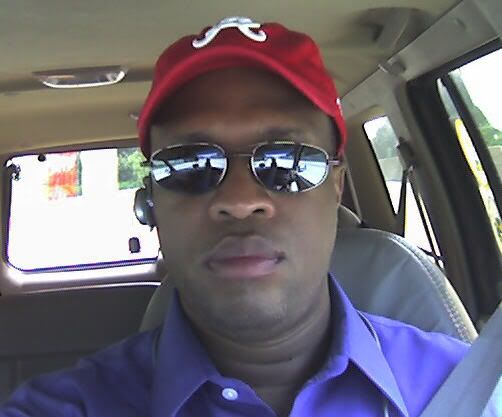
The Atlanta Journal-Constitution reports that James Brown - Godfather of Soul - has passed away at the age of 73. We've lost a great one.
An excerpt from the AJC article:
Brown's energy and charisma were a part of his personality both on and off stage.
When Brown sat for sculptor John Savage, Savage knew what sort of statue he wanted to create: a serious, classic, life-size bronze that would occupy a place of honor in Brown's hometown of Augusta.
"Like any classic sculpture, there would be no smile on the face," said Savage.
Brown hated the idea.
"Asking him to sit there and look serious, he absolutely looked like he was going to jump out of his skin, posing like that," said Savage. "He told me that he was all about happiness and joy; he was a smiling man, and he wanted a smile on his face."
There was joy in Augusta on May 6, 2005, when the statue was unveiled at a downtown park very near the street that had been renamed James Brown Boulevard in Brown's honor. Thousands lined the streets for a dedication that was a love fest between the town and its most famous son. On the face of the 600-pound bronze: a smile as big as day. Even bigger, and more blinding, was the smile on the guest of honor, James Brown, who accepted the accolades from a city that had been slow to celebrate the music legend.
His was a quintessential American success story; he credited his hard-scrabble upbringing for providing the inspiration for much of his music, and hard work for his triumph.
Abandoned by his mother at age 4, raised by his great-aunt in an Augusta whorehouse, Brown became one of the most influential figures in the history of American music. He generated a personal fortune, invented funk, and gave wings to the black power movement while supporting the most conservative of presidential candidates, including Richard Nixon. He was a masterful and demanding bandleader who set a standard for live performance only rarely exceeded. A prolific songwriter, he followed his own instincts, ignored the suggestions of his record labels and created the funkiest, most compelling dance music on the planet.
Though his top chart performance came in the 1960s, Brown's music has seeped into the DNA of American culture, and has been sampled on hundreds of contemporary hip-hop and dance albums, giving his music a persistent presence on the radio, television and in the movie theater.
James Brown was born May 3, 1933, in the piney woods near Barnwell, S.C. The one-room shacks where he lived had no power, no water and no windows. His father, Joe Gardner, was a turpentine worker who was often gone for days at a time. His mother, Susie Behlings, left her husband and child when James was a toddler, and the boy was frequently alone with his father's live-in girlfriends. This left young James to generate his own amusements. "It gave me my own mind," he wrote of his lonely childhood.
When he was 6, his father moved him to Augusta, and he lived in a brothel operated by his great-Aunt Honey, where the rent was $7 a month. His father never lived with him again.
The youngster helped pay for his keep by shining shoes, sweeping out stores and singing in talent contests. Convoys from Fort Gordon frequently traveled over a canal bridge just outside Aunt Honey's place, and Brown would buck dance for the passing troops, who threw change.
"They threw nickels and dimes, and I worked even harder, trying to get them to throw quarters," he wrote in "James Brown: The Godfather of Soul. "Boy, I wanted those quarters."
He was embarassed by his clothes, including his home-made underwear, and was determined to better himself. His determination drove him to break into cars parked in downtown Augusta.
At age 15 he was arrested for burglarizing vehicles. A few months later he turned 16 in jail, and was tried and sentenced to two-to-four years on each of four charges. He served at the Georgia Juvenile Training Institute in Toccoa, where even in prison he found a way to starch and press his blue jeans.
At a baseball game between the prison team and a local team, Brown met local gospel singer Bobby Byrd, beginning a fruitful relationship that would continue for 50-plus years.
"I was the shortstop; he was the pitcher," said Byrd.
Byrd and his family agreed that if Brown were released from prison, they would give him a place to stay and help him find a job. With that endorsement, Brown was freed after serving three years. He came out hungry, and determined to be the master of his own fate. But it wouldn't be the last time he served behind bars.
Brown found work at a garage, and sang with Byrd's group. "We patterned ourselves behind the Soul Stirrers," said Byrd, now a resident of Grayson, Ga. "I'd sing second lead and alto. He sang lead and tenor."
After seeing a Little Richard performance at Bill's Rendezvous, the group decided to turn secular, and to seek out Richard's manager in Macon. No one had any money. "The first night we got to Macon we slept in the graveyard," said Byrd.
First called The Flames, they renamed themselves the Famous Flames, reportedly prompting Little Richard to comment: "Y'all are the onliest people who ever made yourself famous before you were famous."
A talent scout in Macon heard a copy of a tune called "Please, Please, Please" they'd recorded at radio station WIBB (the diminutive Brown had to stand on a Coke crate to reach the microphone) and signed them to King Records in Cincinnati.
Cigar-chomping owner Syd Nathan hated the song, but put it out anyway in 1956. It sold a million copies.
Brown was the obvious centerpiece of the group, but when his managers started calling the group James Brown and the Famous Flames, the rest of the members quit in anger. Brown toured with pickup groups, then in 1957 absorbed some of the members of Little Richard's band after the rock-n-roller left pop music for the ministry.
He continued touring obsessively, sometimes playing 350 shows in a year, and — borrowing from several sources — created a spellbinding show, with tightly choreographed dance moves and theatrical set pieces. Brown would climb into the rafters or leap off the piano and land on the stage in a split. He altered the camel walk and the mashed potato, adding a flashy one-foot glide to fashion his own dance, the "James Brown."
He wanted to catch the intensity of his live shows on record, but King's releases failed to do them justice. Brown decided to make a live concert recording. Nathan wouldn't pay for it, so Brown put up the $5,700 himself.
He recorded a day's worth of performances during a week-long run at the Apollo Theater in Harlem, in the fall of 1962. "Live at the Apollo" stayed on the pop charts for 14 months, peaking at No. 2, which was unheard of for an R&B album. It was a faithful document of Brown's house-wrecking live show, with its rococo introductions from long-time master of ceremonies Danny Ray, and its peaks of intensity and valleys of ballad-singing repose, capped with the tried-and-true show-closer "Please, Please, Please."
It also set a standard of live recordings that has rarely been exceeded.
The music of the reigning black performer of the time, Ray Charles, suddenly appeared "old hat. . . with its orchestra of reading musicians and big-band book," wrote Peter Guralnick in "Sweet Soul Music."
By contrast, Brown was super-heated, and spontaneous. His musicians — the band sometimes had as many as two dozen members — worked from "head" arrangements, and memorized the show backwards and forwards, ready at a moment's notice to segue between songs, change keys, break it down for a solo, or vamp indefinitely if Brown found a chord he wanted to work.
He controlled the group with screams, spoken commands and hand gestures, keeping a sharp eye out for any missteps, bad notes or sloppy dress. Brown punished mistakes with fines levied on the spot. (Five fingers flashed at the perpetrator five times equalled a $25 punishment.)
A steady flow of musicians went through this combative learning experience, usually quitting in frustration to make room for younger players. While Brown battled to get control of his record contract, his music continued to evolve, becoming more and more driving.
Brown bought a Lear jet, and a house in Queens designed to look like a castle, with a drawbridge and a moat.
In the meantime, his politics grew ever more complex.
In 1968 he recorded "Say it Loud (I'm Black and I'm Proud)," which became a rallying cry for the black power movement, rattling the cages of Black Panther-watchers. That same year he released the flag-waver, "America is My Home," drawing criticism from African-Americans and the left. (He'd also recorded "Don't Be A Dropout" around the same time, which was used by vice president Hubert Humphrey for a stay-in-school campaign.)
Brown appreciated music beyond genre classifications. He started out as a gospel performer, frequently used gospel opening acts, and loved the gospel records that Elvis Presley released.
According to his former comptroller Fred Daviss, of Perry, Brown chartered a jet and flew to Memphis on the day after Presley died, and stood in the Graceland living room chatting with the family, paying his respects and crying until early in the morning. Presley and Brown were just "two old country boys," said Daviss. "They loved each other, and loved each other's music."
The end of the '60s brought an end to Brown's chart dominance. He would return to the Top 10 only one more time, with "Living in America," from the 1985 soundtrack to "Rocky IV."
A high-profile cameo in the 1980 "The Blues Brothers" movie also boosted Brown's profile. Other incidents during the 1980s brought him attention for all the wrong reasons. He was arrested on multiple occasions for drug and firearm offenses, climaxing with a bizarre incident in 1988 that resulted in a high-speed chase, ending only after police shot out all four of his tires.
Sentenced to six years, he was imprisoned from 1988 to 1991.
Out of prison, Brown bounced back again, assembling a new band and touring world capitols through the next two decades. He also withstood a steady shower of awards: a lifetime achievement Grammy in 1992 (he had already been inducted into the Rock and Roll Hall of Fame in its first year, 1986); the Songwriters Hall of Fame in 2001, and a Kennedy Center award in 2003 presented in a special ceremony at the White House.
His tumultuous personal life also generated headlines. Adrienne Lois Brown, his third wife, who he married in 1982, had him arrested several times on abuse charges. Yet the two reconciled, and Brown was crushed when Adrienne died of complications from cosmetic surgery in 1996.
Commercially, Brown was resuscitated when hip-hop artists began paying for the samples of his music that they've been borrowing since the 1980s.
Brown's ability to come back from defeat was a theme in his life. Long-time friend and political activist Rev. Al Sharpton touched on that theme during the dedication of the Brown statue in Augusta.
"If you are broken and think you cannot come back, come to Augusta, look at James Brown's statue, and see a man who always came back."
He certainly bounced back from his last prison stint. The Kennedy Award highlighted a fruitful period, during which Brown earned up to $150,000 a night playing to adoring crowds in Europe and Asia and at lucrative festivals in the U.S., according to longtime advance man Bob Patton.
One of his side-men told Rolling Stone magazine that despite the lack of radio hits, the James Brown band would work forever, because James Brown's music is now a part of the American landscape. Like a face on Mt. Rushmore, the craggy Brown profile would never go out of style. "It's like we're up there with Bugs Bunny, Mickey Mouse. There's no other comparison."
Today the band is silent. Their leader has gone from mortal to immortal. But on radios around the United States, you can be assured that the gravelly voice is commanding an audience somewhere: "Get up!"
Check out this boisterous live performance by the Godfather of Soul in Europe from the 1970's with "Get Up (Sex Machine)" and "Get on the Good Foot":
plez sez: James Brown is a personal icon of mine... I love good music and to me, this is where Soul, R&B, and Funk begins! I have the complete boxed set of his music and if you are ever riding in my car, you will undoubtedly be subjected to my singing backup to his "Get Up (Sex Machine)" or breaking out in a "Cold Sweat" or playing that air-trombone with Fred Wesley on "Doing It To Death." James Brown revolutionized soul music, invented funk music, and led the Black is Beautiful movement with his revolutionary hit "Say It Loud, I'm Black and I'm Proud."
My father was the biggest fan of James Brown that I know! He used to regale us with stories of watching James Brown's live shows at the Apollo in New York City in the early 1960's. My father had an 8-track player installed in our Cadillac Coupe Deville and the ONLY tape that we listened to was by James Brown. My father loved to tell us how well that dude could dance and sing and entertain the crowd; my father even wore his hair in a permed pompadour, like the "Godfather." It is my hope that they have finally met up in heaven as the two funkiest brothers at the Pearly Gates!
In his heyday, the "Godfather" was known as the "Hardest Working Man in Show Business," without James Brown, there is no Michael Jackson, there is no Prince, there is no Bootsy Collins, there is no Usher, there is no Parliament, there is no Funkadelic.
In order for me to channel my thoughts into this post, I had to throw on some "Make It Funky" with JB and Bobby Byrd on the intro:
Bobby: What you gonna play now?
JB: Bobby, I don't know... but whatever I play, it's got to be FUNKY!
JB: 1-2-3...Make it funky
ALL: Make it funky - Make it funky - Make it funky - Make it funky!
Oh yes, we've lost a national treasure, but the Godfather's timeless style of music is going to be making us all FUNKY forever!













No comments:
Post a Comment